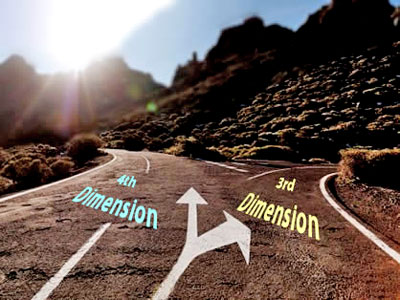|
|
|
from PreventDisease Website
When asked to give a simple definition of this dimension, Edgar Cayce answered with a single word: "idea."
Quite independently, the psychiatrist Carl Jung provided exactly the same, single word definition. The fourth dimension is the realm of ideas, the world of the imagination where we can make anything happen.
It's a big world, infinite; certainly
big enough for one to get lost within it unless you know the secret
of navigation.
Fourth dimensional consciousness is awareness of point, length, breadth, height, volume, and time.
The fourth dimension is also known as
the Astral Plane, and the primary consciousness of this dimension is
the Astral Body, which is also known as the "higher human."
Hence, there is a huge mobility of form. It is the realm of the "shape shifters" of which mythology speaks.
A shaman or holy person who can shape shift has learned to ground their astral form upon the third dimension so completely that they can temporarily change their third dimensional form.
This amusing paradox shows the problem of discussing the fourth dimension with terms derived from the three dimensional world.
Even
to say "movement" in the fourth dimension borrows from the 3-D world
of time and space. Perhaps it would be better to say "changes"
instead of movement, when discussing the fourth dimension, for we
can "travel" in the fourth dimension without moving at all. We don't
actually travel, but rather we change our intentions and thus the
pattern of our experience.
The
fourth dimension offers a novel and intriguing addition to our
worldview that is becoming particularly important today. It provides
the necessary stage upon which we can experience the reality of the
soul. At a time when more and more people are wanting to have a
relationship with soul, it is important to reckon with its fourth
dimensional nature.
Our astral
reality, as well as our other physical incarnations, is not
perceivable to our third dimensional self unless we have remembered
our
Multidimensional Consciousness.
When we are "asleep",
we are unconscious in the third dimension, but we are conscious in
the fourth dimension. Our fourth dimensional Astral Body possesses
advanced dreaming, imagination, psychic ability, intuition, magic,
and creativity. As we expand our mind to frequency of the fourth
dimension, we can experience more and more of these qualities while
in our physical form.
Physical awareness is three-dimensional, soul awareness is of the fourth dimension.
Three-dimensional awareness has the basic qualities, Barrett explains, of time, space and matter. These qualities creates the experiences of separation, death and mass. Fourth dimensional awareness, on the other hand, has the basic qualities of timelessness, spacelessness and energy. These qualities create the experiences of unity, being and flow. In the fourth dimension, there is consciousness of eternity, where past and future simultaneously co-exist.
There is consciousness of omnipresence, in which everywhere is located right here.
In other words, the here and now is "Home Central" of the fourth dimension. There is a sense in the here and now of a permanent sense of being. That being is not of things, but of energy.
As Barrett puts it,
Some people are born with an innate connection to their fourth dimensional self and must "work" to ground their consciousness in a third dimensional world that often feels foreign and hostile. Others are born without this awakened connection, and they usually feel more comfortable and "at home" within the third dimensional paradigm.
These people often feel cut off from the higher
dimensional portions of themselves and may not even believe that
"higher selves" even exist.
One of the most important is for us to look for the our soul's intention behind every experience, to see what we are trying to learn. In the final analysis, the most important lesson is that our ideals become our destiny.
What is yours?
|


